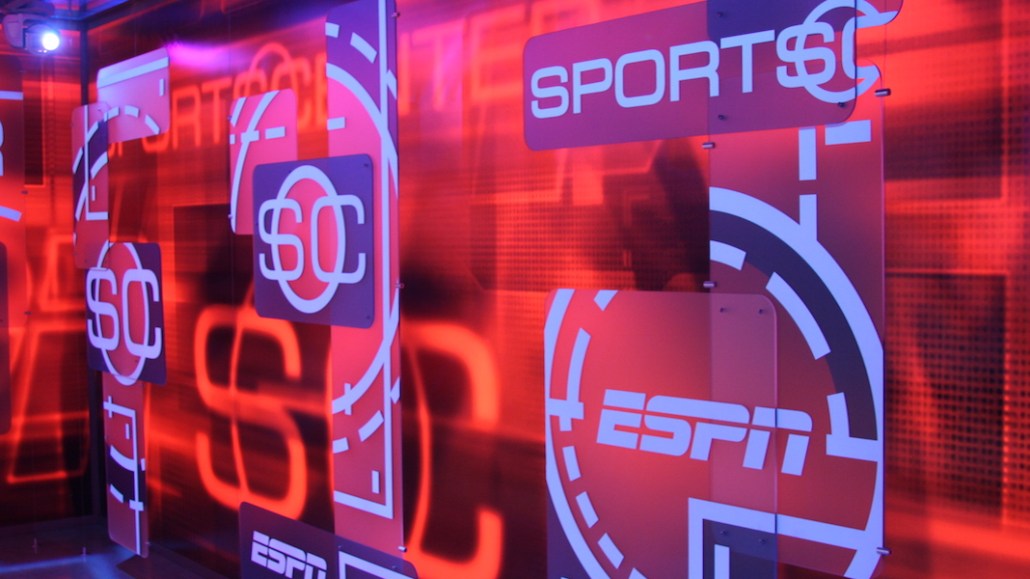Save 50% on a 3-month Digiday+ membership. Ends Dec 5.

ESPN video hacks are like déjà vu all over again: A few months ago Digiday reported that ESPN was displaying false play buttons in the thumbnail image for static links it posted on Facebook. It appears that ESPN has since eliminated these images on Facebook. However, the sports giant still uses them on Twitter.
As seen in the below images, even if it is posting the exact same story, at times ESPN will use a false play button on Twitter, but not on Facebook. If a user clicks on the play button in the tweet, it doesn’t play the video. Rather, it drives users to ESPN’s website, where they are more easily monetized.
Nate Robinson really used height to his advantage. . https://t.co/D5ddu8FaoQ
— ESPN (@espn) February 26, 2017
Outside experts are unimpressed.
“I’m surprised ESPN would mislead their fans and followers, as well as create a negative user experience,” said media industry analyst Rebecca Lieb.
Said Chad Martin, director of social and emerging media at digital agency VML: “Publishers are in a spot where they are doing anything and everything they can to get people to consume their content. This, however, is a bad user experience and I’m guessing they figured that out by the amount of time someone watched the clip. Could be that they stopped on Facebook and not on Twitter because they were told to stop. It is a deceiving way to get clicks.”
Ad position: web_incontent_pos1
ESPN, Facebook and Twitter all declined to comment. Publishers previously speculated that ESPN was risking getting their hand slapped by Facebook for posting misleading thumbnails.
“They [platforms] set the rules within the platform, so it’s best for publishers to follow the rules rather than trying to trick the audience into clicking,” said LittleThings editor-in-chief Maia McCann in November.
Ken Kraemer, CEO of creative agency Moment Studio, said that play buttons create an expected outcome for users and that deviating from that expectation creates for a poor user experience and design.
“Users reflexively click [play buttons] with the expectation that the video will begin playing,” he said. “It is what makes that design element an icon rather than a decoration. It could be seen as misleading – or even a form of link-baiting – to give a user a different outcome than that expectation.”
And yet, apparently ESPN’s hands remain unslapped by Twitter.
Ad position: web_incontent_pos2
A test shows that the false play button image automatically generates when a user tweets ESPN’s links, but these images do not show up when the same link is posted on Facebook. “I haven’t noticed this at all, anywhere,” said Lieb when asked if it is common for publishers to automatically load different images for Twitter and Facebook posts. Lieb went on to say, “It is sort of a sneaky way to boost web traffic.”
https://twitter.com/RossBenes/status/836981727427964928
Image via Creative Commons
More in Future of TV

Future of TV Briefing: The streaming ad upfront trends, programmatic priorities revealed in Q3 2025 earnings reports
This week’s Future of TV Briefing looks at what TV and streaming companies’ latest quarterly earnings report indicate about the state of the streaming ad market.

Future of TV Briefing: The creator economy needs a new currency for brand deals
This week’s Future of TV Briefing looks at why paying creators based on reach misses the mark and what IAB is doing to clear up the creator-brand currency situation.

Future of TV Briefing: WTF is IAB Tech Lab’s device attestation tactic to combat CTV ad fraud?
This week’s Future of TV Briefing breaks down the CTV ad industry’s new tool for fighting device spoofing.
Ad position: web_bfu